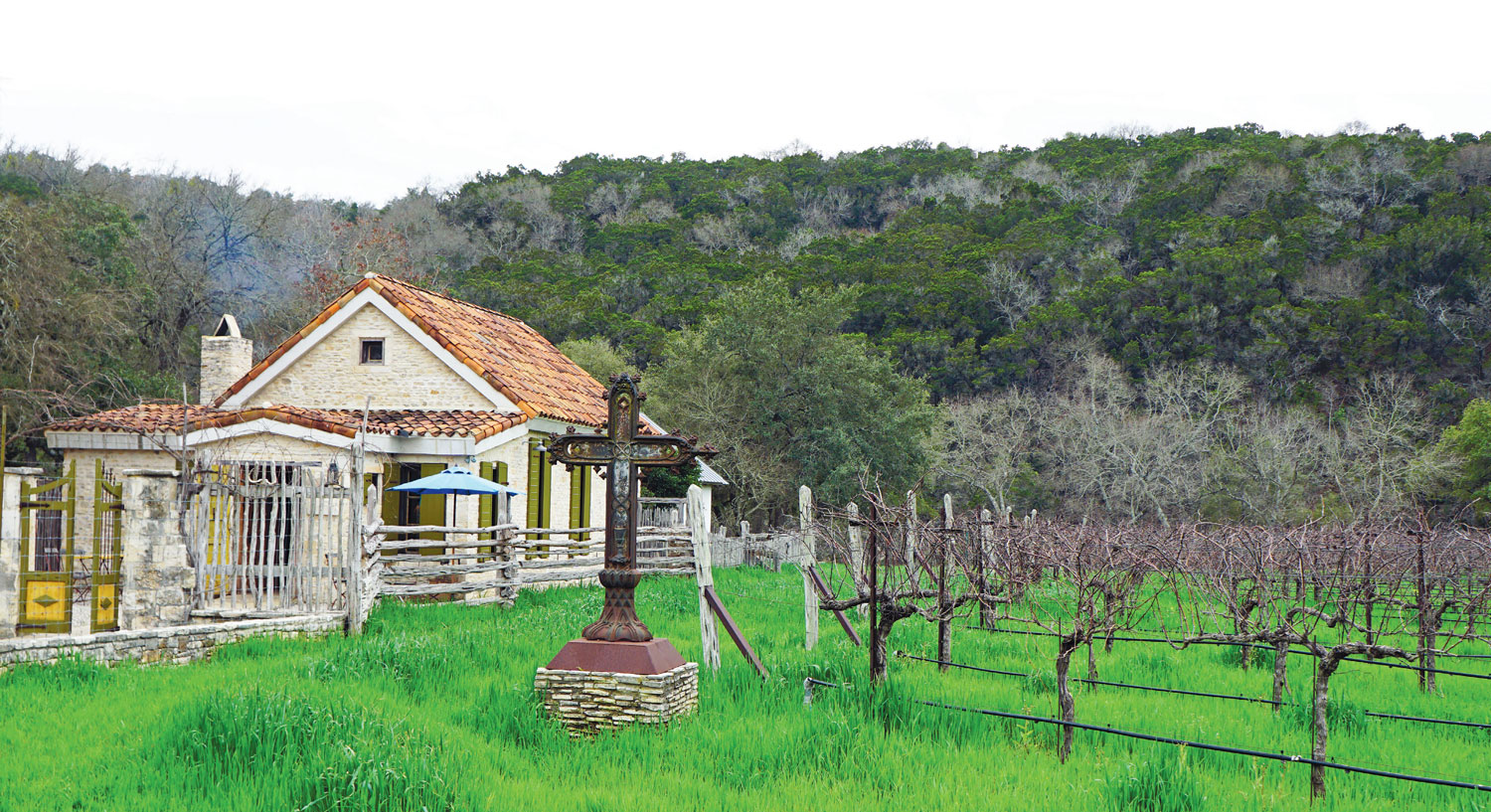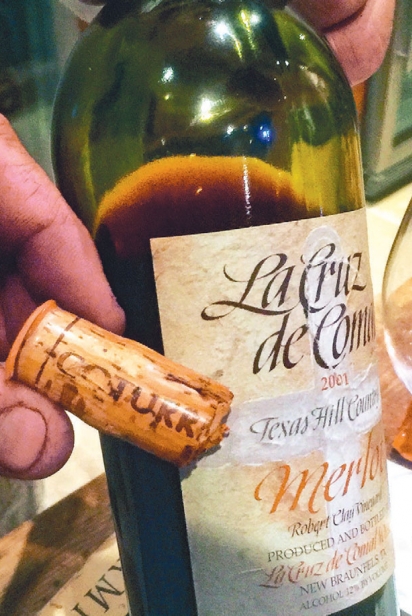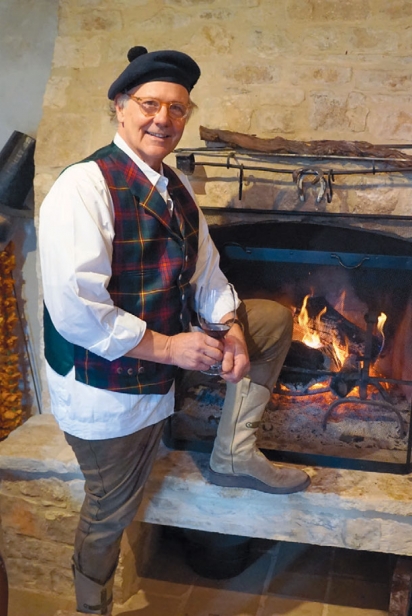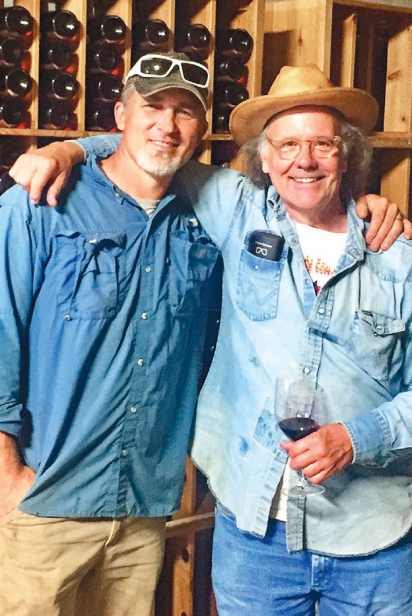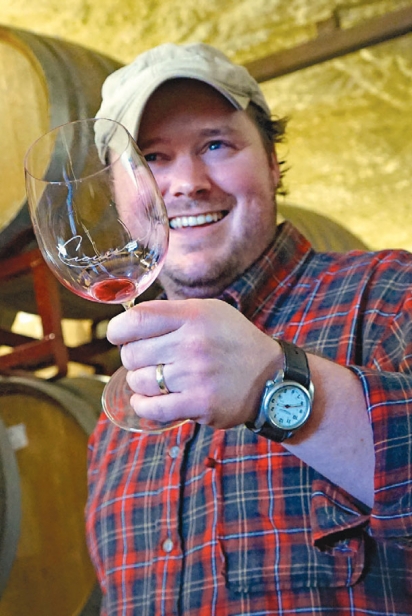Good-Natured Wines from Four Texas Winemakers
Lawyer turns natural winemaker at La Cruz de Comal
Driving north on a rural Texas Hill Country road I nearly missed my turnoff, a narrow path cut through a stand of craggy cedar trees. Without seeing bottom, I quickly descended. A cave cut into a limestone cliff, a small Provençal-style house made of cedar posts and fieldstone, and rows of trellised grapevines accented with a large wrought-iron cross appeared. It was Houston-lawyer-now-winemaker Lewis Dickson’s La Cruz de Comal vineyard just west of New Braunfels.
Dickson’s operation has the accoutrements of winemaking, but different from what is expected in modern wineries. He produces his wine using a method taught to him by friend Tony Coturri, with indigenous yeasts that settle naturally on his grapes, not modern cultured strains. Furthermore, Dickson’s wines are made from 100% Texas-grown grapes, but the grapes are different, too. They are not the classic European varieties normally used in winemaking. His grapes are French-American hybrids that he feels better handle the harsh Texas climate and vineyard diseases.
Dickson discovered an interest in wine even before he reached legal drinking age. “And while getting my law degree I began to realize that wine was an art form to be appreciated. Having a glass of wine was different from having merely a beer,” says Dickson.
Fast-forwarding to the 1980s, he was practicing law in Houston with his partner Dick DeGuerin and big-name associates like Richard “Racehorse” Haynes. Dickson admits he was professionally “going about 110 miles an hour” when he took an ownership stake in a California vineyard.
“I’d get out there several times a year and play around in the tasting room and give them some input on blends,” says Dickson. “I had no real interest in actually making wine, but what fascinated me was the coming together of the elements and Mother Nature in the vineyard ending up in the wine.”
On these California trips, Dickson struck up a friendship with winemaker Tony Coturri, who was then and remains today a cult hero for making wines by age-old traditional methods. Wines like Coturri makes are often referred to as “natural,” due to the minimalist winemaking methods. They strive to be pesticide- free, free of added sulfites, additive-free and use natural wild yeasts for fermentation. Many who follow these wines believe that such techniques provide a natural essence in the wine—described by the French term terroir (tehr-WAAR), meaning “a sense of place or origin.”
Natural wines are often portrayed in stark contrast to “modern, New World or international-styled” wines from recent decades under the influence of famed wine evaluator Robert Parker. These “Parkerized” wines tend to focus on ripe-fruit-driven muscularity and the power of high alcohol. They typically employ plenty of enzyme additives, powdered and liquid tannins and powerful yeast strains that winemakers like Coturri feel overpower the wine’s own terroir.
In the late 1990s, Dickson took a “sabbatical from law” and lived in France for two years, one in Provence. “I was struck by the similarity of the terrain there and back on my Hill Country property—the hills, soil and all the limestone,” he says. “In 2000, when I came back to Texas, I called Coturri and told him that I was thinking about planting a vineyard on my property. I liked his wines and we talked about him mentoring me in winemaking. In 2001, while my vines were slowly advancing, I was able to get some Merlot grapes that I really liked from Robert Clay Vineyards in Mason and we began making wine.”
Dickson planted 11 grape varieties, mostly European vinifera grape varieties, but it became obvious that the European varieties like Sangiovese, Cabernet Sauvignon, Mourvèdre and Tempranillo were not going work for him. “They all died due to disease or freeze,” he says, “leaving me with only two hybrid varieties in my vineyard: Blanc Du Bois, my white, and Black Spanish, my red. I figured these grapes survived and I was going to stick with them.”
Dickson became aware that Blanc Du Bois and Black Spanish were not like European vinifera because they offered different characteristics than the wines most people know. Best of all, he feels they “accentuate the authentic, natural and local character” of his wines.
Most notable in Dickson’s wines is his Petard Blanc made with naturally fermented Blanc Du Bois, bottled unfiltered, unfined and without added chemicals and sulfite. “The French describe an explosively crisp wine like this using the word petard, which translates to firecracker. In addition to the acidity, it has salinity and minerally components coming straight from the vineyard and is extremely food friendly, especially with Gulf seafood and oysters,” says Dickson.
A growing list of Texas winemakers are following in Dickson’s footsteps. On a recent Hill Country trek, I tasted wine with discernably different, natural winemaking interpretations. Each winemaker readily showed their connections to Dickson and Coturri, displaying cell phone photos and videos shot on meet ups where they shared their wines for friendly but serious peer evaluation while hoping to learn still more from their mentors.
Henry Crowson, of Crowson Wines, shared his wines with me in his Johnson City tasting room. These wines displayed a full range from a Sangiovese rosé to full-bodied reds like Zinfandel, Tannat and Montepulciano. Crowson claims to be “all in” to natural wines after he tasted a Coturri-made Zinfandel. Crowson’s unfiltered rosé offered a hazy pink-hued orange appearance in the bottle with a quarter inch of white sediment at the bottom. It was expressive, lively and quite enjoyable with its minerally spirit and notes of tart red cherry and blood orange.
By comparison, Silouan Bradford, of Saint Tryphon Vineyards near Boerne, takes a watchful approach to natural winemaking using it with his Hill Country Blanc Du Bois planted at Dickson’s suggestion and his cuttings. Like Dickson’s Petard, it offers sprite acidity, rich citrus/pear characteristics with chalky aromatic notes of wet Hill Country limestone. “I tend to refer to my winemaking approach as minimalist—natural with Blanc Du Bois. However, I do it selectively when dealing with vinifera grape varieties from specific High Plains vineyards like my ‘Wild Fermented’ Farmhouse Vineyard Mourvèdre. This wine started fermentation naturally.” However, Bradford is not a natural wine fundamentalist and at times opts for a light sulfite addition at bottling to add stability in storage.
Another natural wine experimenter is Dan McLaughlin, a successful IT consultant who admits to having a midlife course correction when he “got the urge to grow something,” afterwards settling on wine grapes. Then he stepped up to take on the challenge of bringing back the fallow 15-acre Robert Clay Vineyards (RCV) in Mason after its years of inattention. McLaughlin learned as he worked and now this vineyard is again a sought-after source of Hill Country grapes. Since getting his vineyard in shape and now with his sights set on starting his winery, McLaughlin is trying his hand at both organic grape-growing and natural winemaking, which he calls “no small task.”
“My goal is to make wine as natural as I can, free from unnatural things both in the vineyard and winery,” McLaughlin says. “If possible, I don’t want to put anything in the wine that I wouldn’t normally ingest.” The natural wine McLaughlin shared with me advertised on the label “Raw Wine, Spontaneous Ferment.” The wine, red-black and nearly opaque, was chewy with tannins. It was a dark berry mélange of flavor, a big-Cabernet lover’s delight. The pleasure was accentuated further by its lively aromatics in the glass with notes of earth, dried herbs and cedar that McLaughlin attributes to natural winemaking and bottling without sulfites.
McLaughlin communes and tastes regularly with Dickson and when possible Coturri, too. On a recent meetup, Dickson had a couple of special bottles to share with McLaughlin. One was Dickson’s well-aged La Cruz de Comal 2001 Merlot, the grapes coming from the same Robert Clay Vineyards that McLaughlin later saved from demise. It was the wine Coturri used to teach Dickson his art of natural winemaking. The second bottle was a recent release Dickson made from his own Black Spanish grapes combined with McLaughlin’s 2018 Merlot with a label note from Dickson acknowledging Dan and his wife, Jeanie, for their “sustained and passionate work at RCV.” I believe an old adage sums it up: What goes around DOES come around… Naturally!
WHERE TO FIND
La Cruz de Comal
7405 FM 2722, New Braunfels
Crowson Wines
102 N. Avenue G, Johnson City
Saint Tryphon Vineyards & Farm
24 Wasp Creek Rd., Boerne
Robert Clay Vineyards
113 Austin St., Mason (opening soon)


